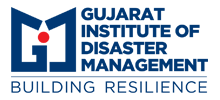| 1 |
Basic Course on Disaster Risk Management |
For long we have been taught that disasters are of two types, natural and man-made. Isn’t it? But very few of us are aware that, according to recent developments based on years of research, it has been proved that disasters cannot be natural?
We are often taught that earthquakes, cyclones are examples of disasters. But imagine if there’s an earthquake and no one is hurt or no buildings are damaged, should we still call that earthquake a disaster? Events like earthquake, cyclones become a disaster when it combines with EXPOSURE and VULNERABILITY to cause loss of life, hurt and injury to people, along with economic loss. But are we trained enough to see a disaster as a combination of factors like hazard, exposure, vulnerability, and coping capacity?
Duration of course: 5 Hours
For More Details: (https://gidm.gujarat.gov.in/en/learning-management-system)
|
|
| 2 |
આપત્તિ જોખમ વ્યવસ્થાપનનો બેઝીક કોર્ષ |
લાંબા સમયથી આપણને શીખવવામાં આવ્યું છે કે આપત્તિઓ કુદરતી અને માનવસર્જિત બે પ્રકારની હોય છે. ખરું ને? પરંતુ આપણામાંથી ઘણા ઓછા લોકો જાણે છે કે, વર્ષોના સંશોધન પર આધારિત તાજેતરના વિકાસ અનુસાર, તે સાબિત થયું છે કે આપત્તિઓ કુદરતી હોઇ શકે નહીં
આપણને સામાન્ય રીતે શીખવવામાં આવે છે કે ભૂકંપ, વાવાઝોડું એ આપત્તિઓના ઉદાહરણ છે. પરંતુ કલ્પના કરો કે જો ભૂકંપ આવે અને કોઈને ઇજા ન થાય અથવા કોઈ ઇમારતોને નુકસાન ન પહોંચ્યું હોય, તો શું આપણે તે ભૂકંપને આપત્તિ કહીશું? ભૂકંપ, વાવાઝોડું જેવી ઘટનાઓ આપત્તિ ત્યારે જ બને છે જ્યારે તે આર્થિક નુકસાન સાથે જાનમાલનું નુકસાન, અન્ય વિપરીત અસરો અને લોકોને ઇજા પહોંચાડવા માટેની નબળાઈઓ અને સંસર્ગ સાથે જોડાય છે. પરંતુ શું આપણને આપત્તિજોખમ (Disaster Risk), સંસર્ગ (Exposure) , નબળાઈ ( Vulnerability) અને પહોંચી વળવાની ક્ષમતા (Coping Capacity) જેવા પરિબળોના સંયોજન તરીકે જોવા માટે પૂરતી તાલીમ આપવામાં આવી છે
Duration of course: 5 Hours
For More Details: (https://gidm.gujarat.gov.in/gu/learning-management-system-0)
|
|
| 3 |
School Safety & Security in English |
The National Education Policy, 2020 lays down the goal of every educational institution- “A good educational institution is one in which each student feels welcomed and cared for, where a safe and stimulating learning environment exists, where a wide range of learning experiences are offered, and where good physical infrastructure and appropriate resources conducive to learning are available to all students. Attaining these qualities must be the goal of every educational institution.”
‘School Safety and Security’ has been defined as the creation of safe environments for children starting from their homes to their schools and back. This includes safety from large-scale 'natural' hazards of geological/climatic origin, human-made risks, pandemics, violence as well as more frequent and smaller-scale fires, transportation and other related emergencies, environmental threats, and violence that can adversely affect the lives of children.
Duration of course: 1 Day
For more details: https://gidm.gujarat.gov.in/en/school-safety-security
|
|
| 4 |
શાળા સલામતી અને સુરક્ષા |
નેશનલ એજ્યુકેશન પોલિસી, 2020 દરેક શૈક્ષણિક સંસ્થાનું ધ્યેય નિર્ધારિત કરે છે-
દરેક શૈક્ષણિકએ ખાતરી કરવી જોઈએ કે શાળાઓમાં વિદ્યાર્થીઓ માટે સલામત અને પ્રોત્સાહન આપતું શૈક્ષણિક વાતાવરણ પૂરું પાડવામાં આવે, દરેક બાળક આવકારની લાગણી અનુભવે અને તેની સંભાળ રાખવામાં આવે. તમામ વિદ્યાર્થીઓ માટે ઉપલબ્ધ યોગ્ય સંસાધનો સાથે વ્યાપક શિક્ષણ અનુભવોની શ્રેણી અને સારી ભૌતિક માળખાકીય સુવિધાઓ પ્રદાન કરે.
શાળા સલામતી અને સુરક્ષા' નો અર્થ એ છે કે બાળકો માટે તેમના ઘરેથી શરુ કરીને શાળા સુધી અને શાળાએથી ઘર સુધી સલામત વાતાવરણનું સર્જન કરવું, જેમાં ભૂકંપ, પૂર, વાવાઝોડુ અથવા કોવિડ -19 જેવા રોગચાળા અને અન્ય જોખમો કે જે વારંવાર અને નાના પાયે ઉદ્દભવતા હોય જેમ કે આગ, માર્ગ અકસ્માતો જે શાળામાં જતા બાળકોના જીવન પર પ્રતિકૂળ અસર કરી શકે તેવા સંકટો સામે સજ્જતા કેળવવાનો છે.
Duration of Course: 1 Day
For more details: https://gidm.gujarat.gov.in/gu/school-safety-security
|
|



